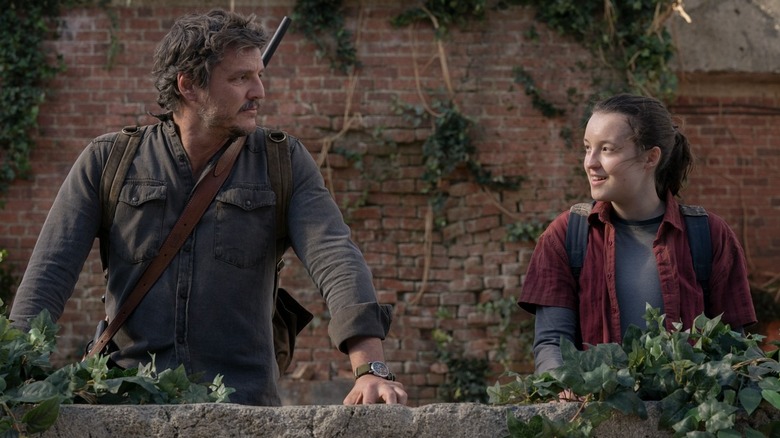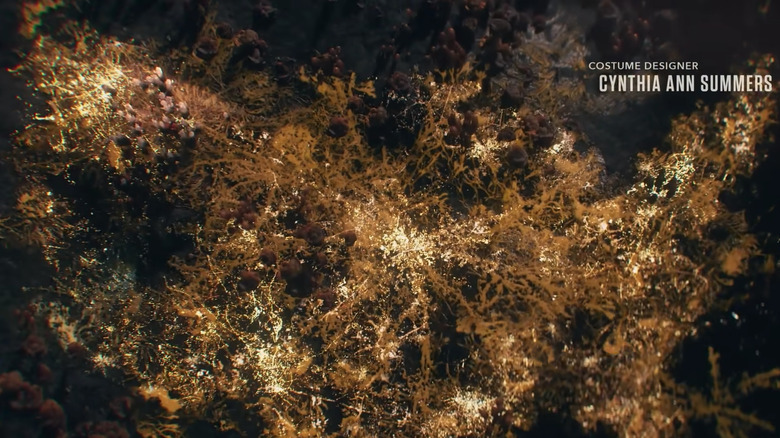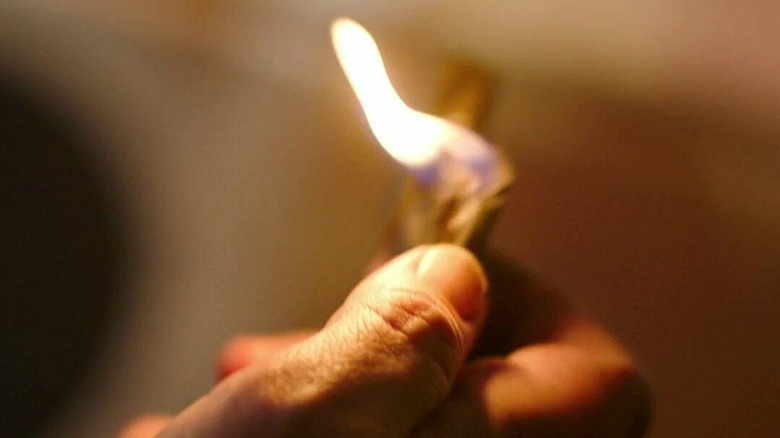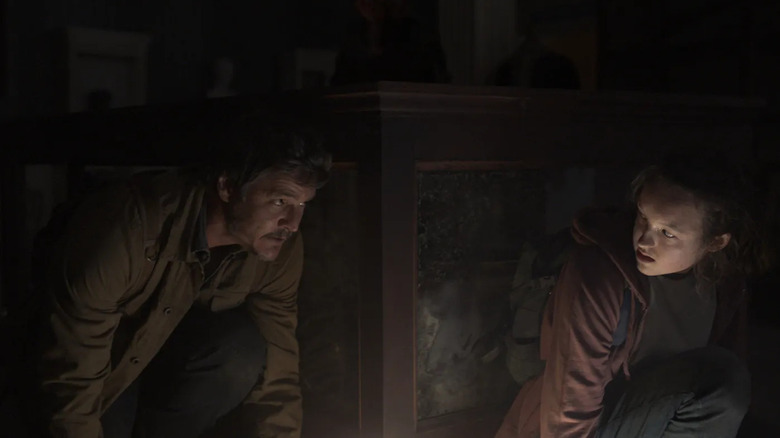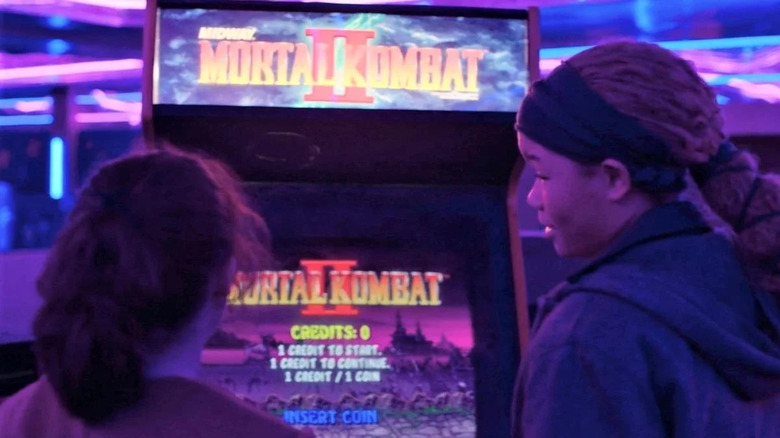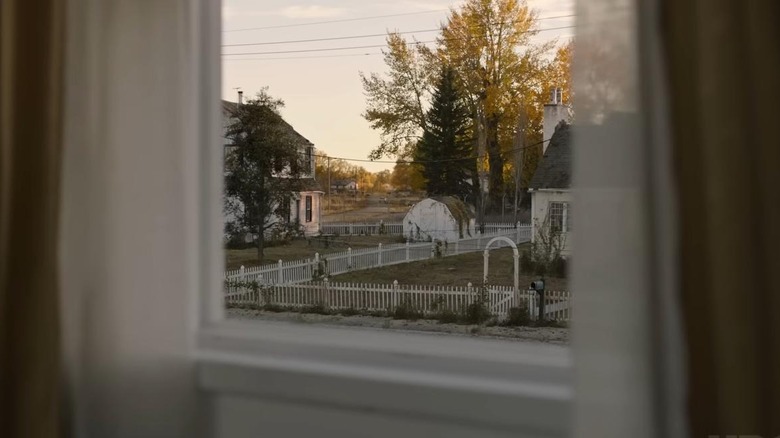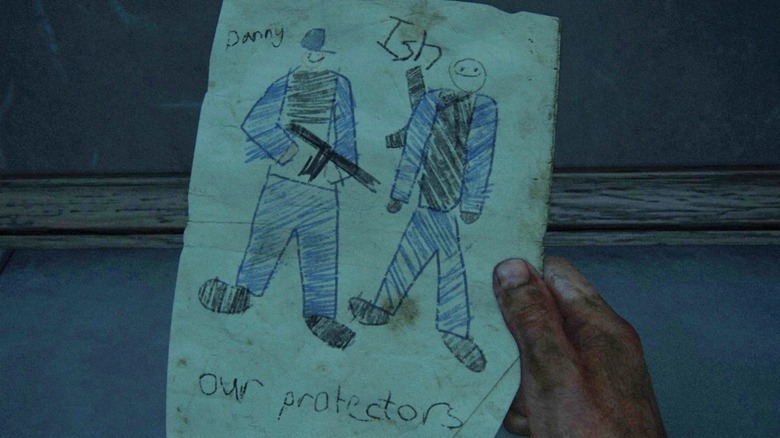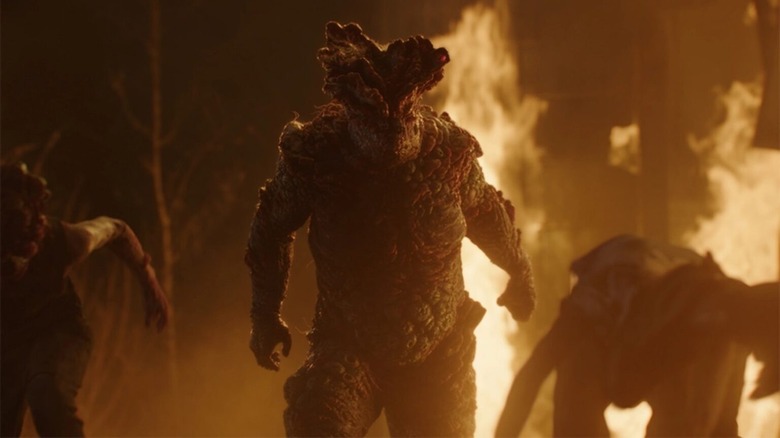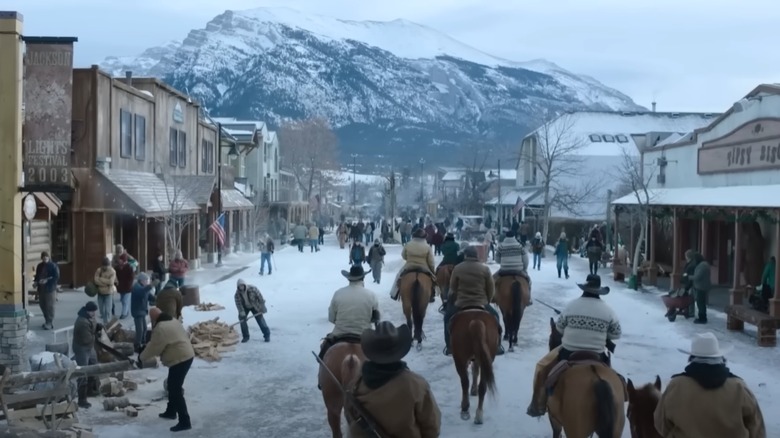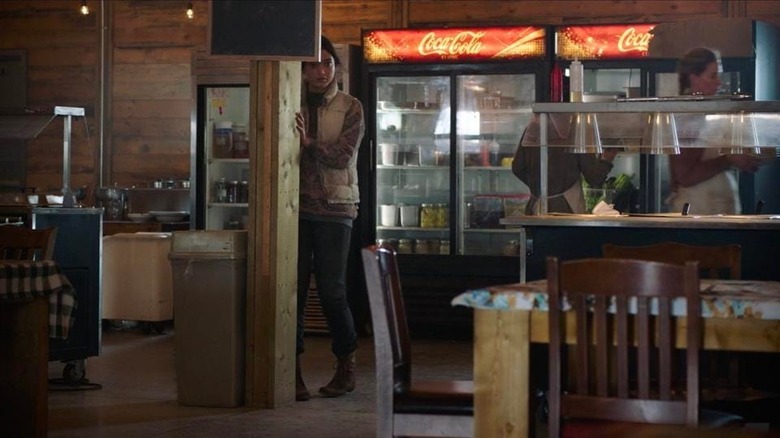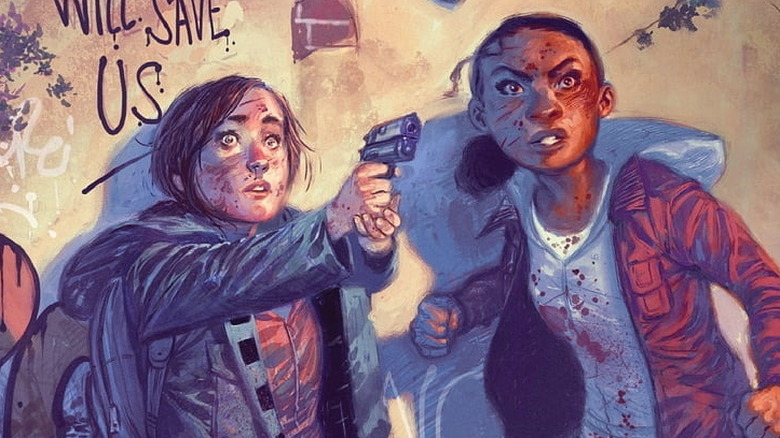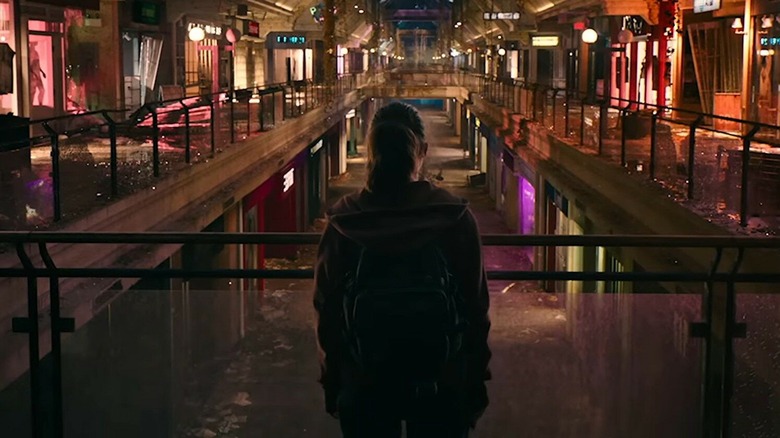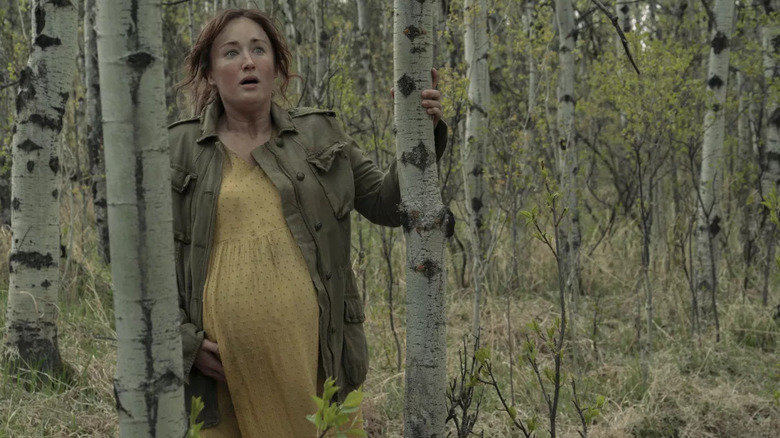The Coolest Easter Eggs We Found In The Last Of Us Season 1
This post contains spoilers for "The Last of Us" Season 1
"The Last of Us" has concluded its nine-week victory lap, and while we're all still picking up the pieces from the intense finale, it won't be long before plenty of folks jump into full-season rewatches to see what they missed. One of the many things that make "The Last of Us" one of the greatest video game adaptations ever made is that the source material isn't abandoned in the transition to televised storytelling. Since the series was co-created by creative director Neil Druckmann and includes direct input from game developer Naughty Dog, a serious effort has been made to bring as much of the game and its surrounding universe to the show as possible in good faith, including some amazing details.
If you know what you're looking for, there are tons of fun Easter eggs to be found, referencing both the original game and the wider series, with an emphasis on the second part of Joel and Ellie's story. This is not a comprehensive list of every single one in HBO's "The Last of Us" — these are the cleverest, deepest, and most enjoyable Easter eggs across the series organized chronologically.
Seattle opening (All episodes)
Like any great opening sequence, the animation that kicks off each episode of "The Last of Us" is beautifully strewn with iconic visuals and references, from the lumps of fungus resembling the starring pair to the use of the game's main theme, completely unaltered (a frustrating rarity in video game adaptations). But one of them is both quick and vague enough to miss.
In the middle of the titles, the traveling cordyceps parasite spreads across an abstract surface to create a shape resembling the United States of America. An exceptionally large concentration of the fungus gathers on the far upper-left side, where the Pacific Northwest region of the country is located. This area is of course home to the famous rainy city of Seattle, the central location of "The Last of Us Part II." It's a real blink-and-you'll-miss-it reference, so it's a relief that audiences have nine chances to spot it.
Light one up for Sam Drake (Infected)
Sometimes, it's the little things in life that really matter — like a pocket lighter. There are plenty of tiny, uninterrupted references across "The Last of Us" — a Naughty Dog keychain here, a "Dawn of the Wolf Part 2" poster there, and so on — but none of them is much of a referential leap, hence their exclusion from this list ... that is, except for one.
Though it'll probably go unnoticed by most viewers and even fans of the original game, Tess' lighter is noticeably engraved with a lone star and the number "76" — a distinct design to be sure, and one with a clear origin. The day after the episode aired, Naughty Dog confirmed the lighter is a recreation of the one belonging to swashbuckling explorer Sam Drake in the "Uncharted" series, the developer's previous juggernaut franchise. Unfortunately, no references to other Naughty Dog properties like "Jak and Daxter" or "Crash Bandicoot" are in this season — here's hoping a few find their way into the next.
Pedro Gear Solid (Infected)
The most consistent problem with video game adaptations — dating all the way back to 1993's "Super Mario Bros." — is the way the gameplay is inherently ignored. The creative team has to strip away the interactivity and design a narrative around what's left, which often isn't enough to satisfy on a feature-length scale (let alone a TV show). Given its reliance on traditionally-shot cutscenes as its primary storytelling vehicle, "The Last of Us" is among the few video games that could be successfully adapted without any gameplay — and yet, they put some in anyway.
During the show's introduction to the horrifying Clickers, Joel and Ellie quietly make their way past the creature with an emphasis on crouch and cover in the Freedom Museum of Boston, a location also used in the game. The sequence is, pose-for-pose, a direct aping of the stealth gameplay that defines every Clicker encounter in the game. If only Joel had entered "Listen mode" while he was at it.
Turning Kombat (Long Long Time & Left Behind)
We've all seen it before: A video game or TV show spotlights an in-universe piece of media that is clearly intended to be the copyright-friendly equivalent of a real thing in our world. "The Last of Us" features two pop culture analogs — one is "Dawn of the Wolf," Naughty Dog's parody of "Twilight," whose poster makes a quick appearance in "Kin." The other is "The Turning," an ultra-violent fighting game equivalent to "Mortal Kombat."
Since Warner Bros. Discovery owns both HBO and the "Mortal Kombat" license, the adaptation cuts out the middleman entirely, allowing Ellie to enjoy a few rounds of "Mortal Kombat II" with Riley in "Left Behind" and describe fan-favorite character Mileena to Joel in "Long Long Time" (instead of describing Angel Knives to him as she does in the game). It's very rare to see an adaptation outright reference a work that was originally obscured to avoid copyright infringement.
Rear window (Long Long Time)
There are a thousand ways to end an episode of television — so how do you end one of the best? "Long Long Time" is arguably the crown jewel of this nine-episode treasure trove, and though it deviates from the source material more than any other, it includes one of the most obvious nods in the series. As Linda Ronstadt's titular gem plays, Joel and Ellie drive away from Bill and Frank's humble abode in Lincoln, Massachusetts, viewed from the dearly departed couple's bedroom window.
Anyone who's even turned on the original game will immediately recognize the interior-window shot as the game's title screen, now mirrored and featuring an open window instead of a closed one. Craig Mazin revealed (via Inverse) each episode was originally going to open with a window shot (akin to turning on the game to "play" the episode), but the idea never made it past conception. Instead, the iconic shot became a one-bullet-in-the-chamber opportunity. The chosen placement is nothing short of a bullseye.
Call me Ish (Endure and Survive)
A core part of "The Last of Us” as a game is its abundance of environmental storytelling. The scattered notes and messages spread across each area give insight into the denizens of this cursed timeline (and also tell players the combination of a nearby safe they can loot). Amid the standalone letters and journal entries from parents, kids, and soldiers is the tragic, multi-documented tale of Ish, who took to the sea for safety until he ran out of supplies, returned to land, and created a commune with a group of families in the Pittsburg sewers (changed to Kansas City in the adaptation) before a horde of infected breach the community and kill almost everyone.
Though Ish's story is absent from the show, a child's drawing of him — lifted directly from the game — is given a full close-up, confirming his story made the jump to the small screen. Melanie Lynskey, who plays Kathleen, further solidified Ish's canonical significance when she confirmed the little girl Clicker who kills her character was a resident of Ish's communion.
Bloater kill (Endure and Survive)
As any distinguished fan of "The Last of Us" will tell you, nothing in its fungal dystopia brings out more stress and fear like Bloaters, huffing and stomping mushroom homunculi who run fast and kill faster. It doesn't matter how much ammo you're carrying or how full your health bar is — if a Bloater gets its hands on Joel, it's game over.
During the Bloater's great and terrible appearance at the climax of the Kansas City saga, Kathleen's trusted ally Perry takes aim at the creature in a doomed attempt to protect his leader. It doesn't take long for the swollen shroom-hulk to get its hands on Perry and enact the exact same execution it pulls on players: grabbing both sides of his jaw and pulling them apart. The screen cuts to black before it gets really ugly in the game, but in the show, no such mercy is allowed, as Perry is decapitated like paper. It's one thing to include an enemy from the game, but to also include its signature kill animation? What a way to go.
Homes of future past (Kin)
Most adaptations of long-form narratives — whether they be from thousand-page literary epics or 15-hour video games — will put in the effort to streamline where they can, to make sure audiences outside the hardcore crowd can follow along and enjoy. "The Last of Us" sticks to its guns as much as possible, but it does take steps to simplify and include references to stories yet to come. Perhaps nowhere is that more apparent than in "Kin."
In the game, the section the episode adapts takes place at a hydroelectric dam, but in the show, it's moved to Jackson, Wyoming. It's not actually a new location to the series — Jackson is the town Joel and Ellie reach at the end of their story, and where they live comfortably into the events of "The Last of Us Part II." The episode taking place in winter (the game's Tommy section is set during autumn) confirms the reference, as it's the same season as the beginning of "Part II," complete with a snowball fight.
Secret of the 'Staring Girl' (Kin)
Just how assured were Neil Druckmann and Craig Mazin that their video game adaptation would be renewed for Season 2? The closer you look at their first season, the larger that presumed confidence grows. Jackson's appearance itself is a huge allusion to "The Last of Us Part II," but perhaps an even bigger indicator that Season 2 was always in the cards is a single shot of a background character who doesn't even have a name.
After Ellie and Joel reach Jackson, a curious Ellie catches one of the younger residents eyeing her from across the mess hall. Though the girl doesn't speak and is never properly introduced, in perhaps a bit of foreshadowing, her physical appearance bears an unmistakable resemblance to Dina, a central character in "Part II." Credited as "staring girl," she was played by Paolina van Kleef — though we were all excited to learn "The Last of Us" had been renewed for a second season, it's safe to assume no one was happier to hear it than her.
American Dreams (Left Behind)
For a best-selling multimedia franchise, "The Last of Us" has a refreshingly tight continuity. As of March 2023, The series comprises two games, a prequel-ish piece of downloadable content, and the TV adaptation of the first game. But many fans may not be aware that there exists a fifth piece of media under the brand's banner: "The Last of Us: American Dreams" is a four-issue comic series written by creative director Neil Druckmann (naturally) and illustrated by Faith Erin Hicks and Rachelle Rosenberg.
Released on a monthly basis both before and after the first game's launch, "American Dreams" recounts the budding friendship between Ellie and Riley, which would eventually blossom into the "Left Behind" DLC that was released a year later. During the TV episode that adapts "Left Behind," Riley quietly snatches Ellie's precious Walkman when she's not looking, something she also does in the first issue of "American Dreams." It's the only reference to the comic in the whole series — a cut deeper than anything else.
An a-ha moment (Left Behind)
Like most pop culture nowadays, "The Last of Us" makes room on its plate for some good ol' fashioned 1980s worship — at least, that's what it appears to be initially. When Ellie and Riley reach the abandoned mall in "Left Behind," a-ha's immortal '80s classic "Take on Me" blasts as the pair explore the derelict slice of suburban commercialism. The selection is fitting — Ellie's worn-out Walkman is a prominent part of her gear, and it darkly gestures to the in-universe meaning '80s music carries in the show.
But that's not all. Those keyed into the series' mythos know "Take on Me" is a significant song in the fatalistic fungal franchise completely outside of the nostalgia cycle. An older Ellie serenades her lover Dina with the song on her acoustic guitar in one of the few moments of levity in "The Last of Us Part II."
Voices of the people (Various)
"The Last of Us" was celebrated for its incredible cast of voice actors who brought humanity and authenticity to each and every character — especially Joel and Ellie, played by Troy Baker and Ashley Johnson, respectively. When the HBO adaptation was announced, there was no doubt the characters would be recast with screen actors, which was always going to rattle some fans the wrong way. But in a surprising twist, the key creatives didn't leave the original voice actors behind.
Baker was cast as David's right-hand man, James, and Johnson plays Ellie's mother Anna (a character never-before-seen in the games). That's not all: Jeffrey Pierce, the voice of Joel's brother Tommy, plays Perry, Kathleen's military confidant (and a completely new character to the series), Merle Dandridge reprises her role as Marlene (itself an impressive and rare accomplishment for any adaptation, game or otherwise), Laura Bailey, the voice of main character Abby in "Part II," cameos as a nurse in the season finale, and both Misty Lee and Phillip Kovats return as the voices of the gnashing Clickers. If only more media respected voice actors the way "The Last of Us" does.
